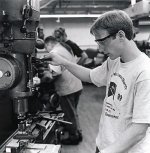JPD
Retina and Rollei user
Not what you are looking for, but worth to mention. Some early folders from the late 1910's till the early 1930's have interesting lenses like the Goerz Dagor, dialytes like Goerz Dogmar or Agfa Doppel-Anastigmat, or four element Double-Gauss lenses like ICA:s Hekla.
The Voigtländer E-Bessa with a 3,5/105 mm Heliar sounds like an excellent choice for you. The Heliar is awesome, as you can see on the photos posted here. The fastest shutter speed is 1/400, and it takes 37 mm slip-on filters and shade. The Heliar has very good "bokeh" wide open, and the result is almost 3D. Superb for portraits. And stopped down to 8 - 16 it's very sharp for landscapes and such. The E-Bessa has a coupled rangefinder. And it's not very heavy.
Folders with Tessar-type lenses, and more modern folders with Double Gauss lenses, are nice, but they lack the "soul" of the Heliar.
The Voigtländer E-Bessa with a 3,5/105 mm Heliar sounds like an excellent choice for you. The Heliar is awesome, as you can see on the photos posted here. The fastest shutter speed is 1/400, and it takes 37 mm slip-on filters and shade. The Heliar has very good "bokeh" wide open, and the result is almost 3D. Superb for portraits. And stopped down to 8 - 16 it's very sharp for landscapes and such. The E-Bessa has a coupled rangefinder. And it's not very heavy.
Folders with Tessar-type lenses, and more modern folders with Double Gauss lenses, are nice, but they lack the "soul" of the Heliar.









